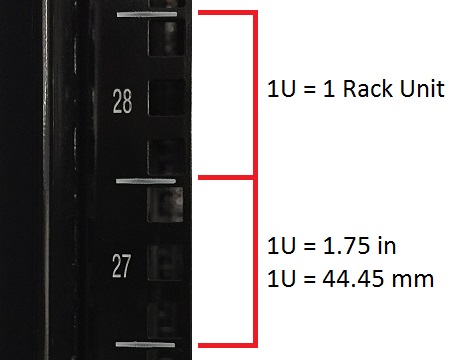Wondering what that RU means on the side of the server box? Trying to figure out if you have enough space for the IT department? This primer on rack units will help you understand what a rack unit is and what you need to know about dimensions, capabilities and how to use rack units to your advantage.

1U spacers in a cabinet
Letters, Numbers, or Both?

1U measurements
When you see the word “rack unit,” two things probably come to mind: a metal shelving unit and units of measurement. You’re on the right track, because both of these are correct. While a rack unit (RU or simply U) is technically the term for a unit of measurement, it only pertains to the height of the space (and the equipment) on a shelving rack designed for electronic equipment.
The term is a standard measurement that comes from the Electronic Industries Alliance. It’s used on a variety of rack mount electronic equipment used for audio/visual, computing and information technology purposes. Servers and network switches are the most common devices measured in RUs.
The rack unit is the height of the equipment that will fit on a rack, 1.75 inches (44.45 mm) high to be exact. So to determine how high your equipment is, or how much space it will take up, in RUs, use basic algebra:
• 1U = 1.75 inches
• 2U = 3.5 inches
• 3U = 5.25 inches
And on and on. Why do you need to know this? That’s where the racks themselves come in. In order to plan your usage of space, you need to know how many rack units you need. Or if you already have racks in use and you’re expanding, you need to know how many rack units you have left on your existing racks.
What a Rack-et!
Racks, like the electronics designed to fit on them, are standardized. They only come in two widths: 19-inch (482.6 mm) and 23-inch (584.2 mm) units. Although they’re both designed to hold electronic equipment, the 19-inch racks are the most commonly used today. The height can vary in, you guessed it, RUs. A standard full height rack is 42 RUs tall, so it will reach six feet (1.8m). A “half-height” rack is usually about 18-22 RUs, which will stand three feet or just under one meter.
When you know how tall your racks are in RUs, you can calculate how much equipment will fit. So if that’s all there is to it, what’s all the fuss? The world is three dimensional, and so are racks. Now that you know how wide the racks are and how many RUs will fit their height, it’s time to learn about depth.
The Depth of the Matter
Depth of the rack unit is where the audio/visual and computing worlds part ways. In the computing and information technology fields, rack-mounted equipment is either full depth or half depth. So if you see the term “half-rack” and it’s referring to servers, switches or other computer/IT equipment, it means that the equipment is one RU high but only half the depth. This is helpful for racks that can be accessed from the front and back and essentially do double duty by mounting two devices at the same level.
For audio/visual equipment, “half-rack” refers to equipment that measures half the width of the rack, not the depth. In this case, the equipment is still one RU high but only 9.5 inches (241.30 mm) wide. So instead of mounting two pieces of equipment back to back like you would with computing/IT, you would mount it side by side on the rack.
Stacking It All Together
And finally, you need to know one final dimension: the mounting holes will be No. 10-32 or 12-24 tapped, or universal square holes. They are unevenly spaced on 19-inch racks and evenly spaced on 23-inch racks.
Now that you know all the dimensions, get stacking! Use them to mount your success.